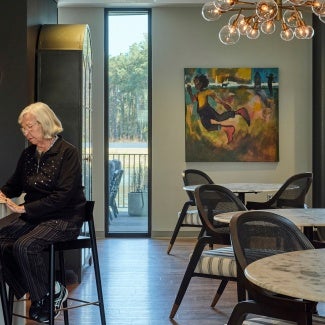Gramercy Senior Housing
The award-winning design for aging of Gramercy Senior Housing in Los Angeles delivers 64 apartments to low-income residents in an expensive market, offering both privacy and engagement with connections to the outdoors woven throughout.

Project highlights: Gramercy Senior Housing
- Architect: Kevin Daly Architects
- Owner: Hollywood Community Housing Corporation
- Location: Los Angeles
- Category: Merit
Built on the site of a block-length lot that was once owned by the city of Los Angeles and served as a towing yard, Gramercy Senior Housing is one of the first developments in the city to capitalize on supportive housing funds. The project, guided by extensive public outreach, delivers 64 sorely needed apartments to low-income and homeless seniors in one of the country’s most expensive housing markets.
Across 70,000 square feet, Gramercy Senior Housing accommodates residents who make less than 50% of the area’s median income and includes a commercial cafe, ample community spaces, and a public plaza on the entry level. The team’s design emerged as six discrete buildings that reflect the scale of the single-family homes that surround it. With bustling Washington Boulevard to the south and a swath of Craftsman homes to the north, the complex appears as an array of structures connected by an exterior walkway system finished with an organic trellis that contrasts with mirror steel hoods that protect windows from southern exposure.
Along the boulevard, the buildings’ massing is taller to shield those on the other side, granting residents an extra measure of privacy and maximizing the light available to the surrounding parcels. The project was optimized for modular construction, and its highly efficient floor plans draw in natural light and ventilation from either end. Courtyard spaces just outside the apartments function as shared living rooms, while an edible garden on the roof provides additional community space.
The project offers residents a sense of place that is particular to the site, differentiating it from typical affordable housing projects in Southern California. The team’s focus on establishing connections to the outdoors across multiple levels ensures residents can engage with their surroundings and neighbors without feeling crowded. Instead of relegating outdoor space to an unused corner of the roof, only accessible by elevator or interior stairs, the team has woven connections to the outdoors through all levels to reach users regardless of their age or mobility.
In addition to bolstering affordable housing in a city facing high levels of homelessness, the project also activates Washington Boulevard, originally built as Los Angeles’ first avenue to the sea. It was once a thriving commercial corridor but has more recently been marked by a mix of small businesses and shuttered storefronts. Prior to construction, the brownfield site was leased to a towing company, which stored its fleet there. The complex’s plaza has helped inject life into the once-abandoned block.
Framework for Design Excellence Measures
Was there a design charrette? Yes
Site area that supported vegetation (landscape or green roof) pre-development: Not applicable
Site area that supports vegetation post-development: 35%
Site area covered by native plants supporting native or migratory species and pollinators: 35%
Strategies used to promote Design for Ecosystems: Biodiversity, Abatement of specific regional environmental concerns.
Is potable water used for irrigation? Yes
Is potable water used for cooling? Yes
Is grey/blackwater reused on-site? No
Is rainwater collected on-site? Yes
Stormwater managed on-site: 100%
2030 Commitment baseline EUI: 90 kBtu/sf/yr
Predicted net EUI including on-site renewables: 40 kBtu/sf/yr
Reduction from the benchmark: 55%
Is the project all-electric? No
Level of air filters installed: MERV 12-14
Was a “chemicals of concern” list used to inform material selection? Yes
Do greater than 90% of occupied spaces have a direct view to the outdoors? Yes
Were embodied carbon emissions estimated for this project? No
Estimated service life: 50 years
Ability to survive without utility power: Not habitable without power.
Has a post-occupancy evaluation been conducted? Yes
Building performance transparency steps taken:
* Present the design, outcomes, and/or lessons learned to the office.
Project team & Jury
Year of substantial project completion: 2021
Gross conditioned floor area: 37,200 sq. ft.
Acoustic: Newson Brown Acoustic Engineers
CASP: RJC Group Inc
Code / Fire: Simpson Gumpertz & Heger
Engineer - Civil: KPFF Consulting Engineers
Land use Attorney: Rosenheim & Associates, Inc.
Landscape Architect: place
Lighting: HLB
MEP/Sustainability: PAE Engineers
Methane Mitigation: Methane Specialists
Soils/Geotech: Geocon West
Specifications: CGA Associates, LLC
Structural Engineering + Shoring Design: John Labib & Associates
Trash & Loading: American Trash Management, Inc.
Waterproofing: James West
Jennifer Sodo, AIA, Chair, EUA, Milwaukee
Winifred Elysse Newman, Assoc. AIA, Clemson University, Clemson, S.C.
Philippe Saad, AIA, DiMella Shaffer, Boston
Margaret Suit, Erickson Senior Living, Catonsville, Md.
Lisa Warnock, Glow Interior Designs, Portland, Ore.
The Design for Aging Review showcases facilities that represent conscientious surroundings and advance environments for senior living.
Five projects showcase the best in senior living communities.













